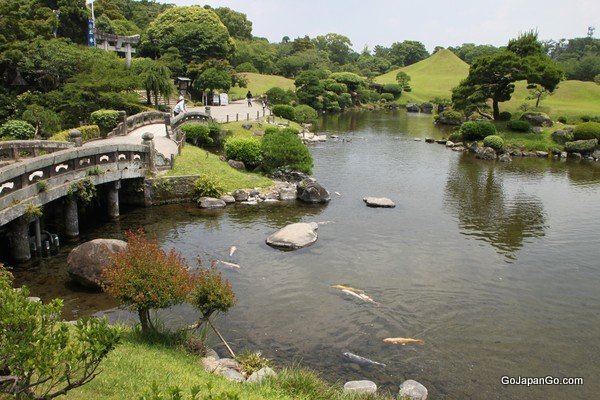Created 1636 | ||
 | ||
Similar Izumi Shrine, Suizenji Jojuen Garden, Kumamoto Castle, Sakuranobaba Johsaien, Hosokawa Mansion | ||
Rybki w suizen ji j ju en
Suizen-ji Jōju-en (水前寺成趣園) is a tsukiyama Japanese garden located within (Suizen-ji Park (水前寺公園, Suizen-ji Kōen)) in Kumamoto Prefecture, Japan. The main tsukiyama is a representation of Mount Fuji. Lord Hosokawa Tadatoshi began construction of the garden in 1636 as a tea retreat. The park was named after a no-longer-extant Buddhist temple called Suizen-ji, and now hosts the Izumi Shrine, where members of the Hosokawa family are enshrined, and a Nōgaku-dō, a Noh theater. Lord Hosokawa selected this site because of its spring-fed pond, which clean water was excellent for tea. The thatched Kokin-Denju-no-Ma teahouse was originally in Kyoto's Imperial Palace, but was moved here in 1912.
Contents
- Rybki w suizen ji j ju en
- Map of Japan E38092862 0956 Kumamoto ken Kumamoto shi ChC5ABC58D ku Suizenji KC58Den 8E288921 E6B0B4E5898DE5AFBAE68890E8B6A3E59C92
- Suizenji Park
- References
Map of Japan, %E3%80%92862-0956 Kumamoto-ken, Kumamoto-shi, Ch%C5%AB%C5%8D-ku, Suizenji K%C5%8Den, 8%E2%88%921, %E6%B0%B4%E5%89%8D%E5%AF%BA%E6%88%90%E8%B6%A3%E5%9C%92
The garden has been declared by the national government a historic site of scenic beauty.
Suizenji Park
Suizenji Kōen is an interesting and much visited venue, featuring miniature landscapes, a temple and small lakes containing large, hungry, and multi-coloured carp. It is a short tram ride from the city. Nearby, there are many souvenir and snack shops.
